If you have a home art studio or craft room, there will come a time when you need to figure out storage solutions for organizing your art supplies.
It’s likely that you have a lot of random things that you use for crafting, and there are tons of products that are available for art studio storage.
But when it comes down to it, what are the things that actual home-based business owners use?
These are some real-life storage solutions that Artisan Shopping Directory members use to corral our own art and shipping supplies.
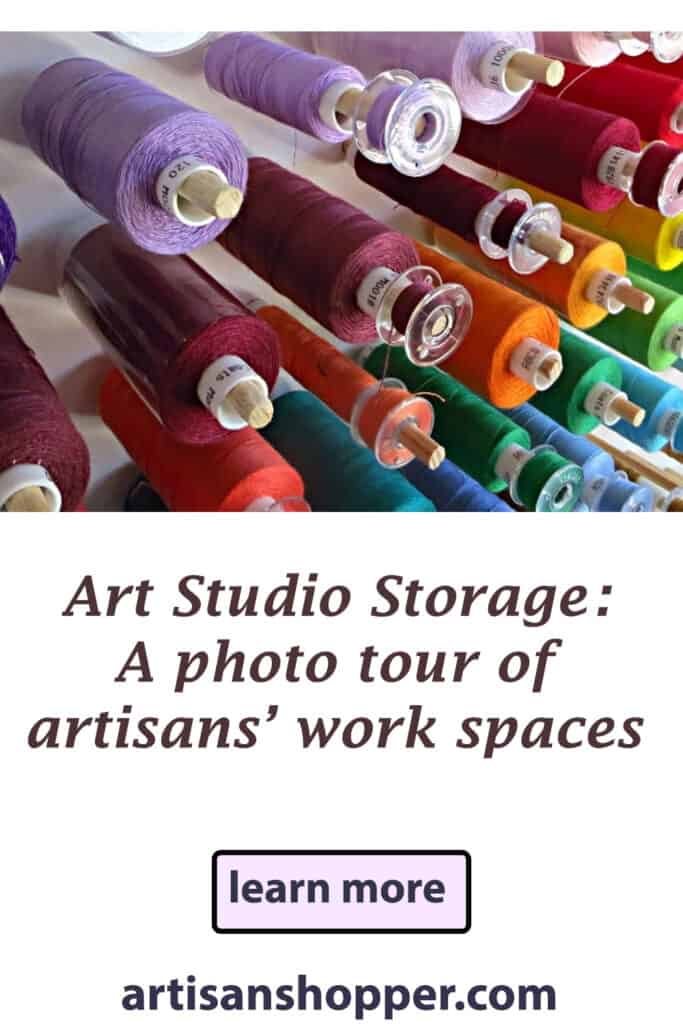
Table of Contents
- Things to consider for art studio storage
- A way to keep supplies categorized.
- How to keep surfaces clear to work, but also keep tools handy.
- A place to put machines that we use on a regular basis.
- Places to dry things.
- Safe storage for liquids.
- A safe workspace for jobs that require ventilation.
- Shipping and packing supply storage and work area.
- Places to keep inventory of supplies and finished products.
- Minimizing “the creep” of supplies into other parts of the house.
Things to consider for art studio storage
There are many things to consider for art supply storage, but for home-based creative businesses, we have to think about more than just where to keep things.
Since we are actively using our supplies every day, we need them to be accessible and visible so that we don’t waste a lot of time searching for things.
There also needs to be a higher level of organization than there would be for a hobby craft room, because not knowing where things are can waste a lot of time.
When the pros set up a studio space, these are the things we have to think about:
- A way to keep supplies categorized.
- How to keep surfaces clear to work, but also keep tools handy.
- A place to put machines that we use on a regular basis.
- Places to dry things.
- Safe storage for liquids.
- A safe workspace for jobs that require ventilation.
- Shipping and packing supply storage and work area.
- Places to keep inventory of supplies and finished products.
- Minimizing “the creep” of supplies into other parts of the house.
A way to keep supplies categorized.
Keeping supplies categorized is very important for home businesses because we need to be aware when we need to reorder supplies that we’re low on, and also where things are when we need them.
This also includes having things visible so that they can be found quickly without having to open a lot of containers.
Please note: Some of the links on this page are affiliate links, which will give me a small commission at no cost to you if you buy something when you use them.
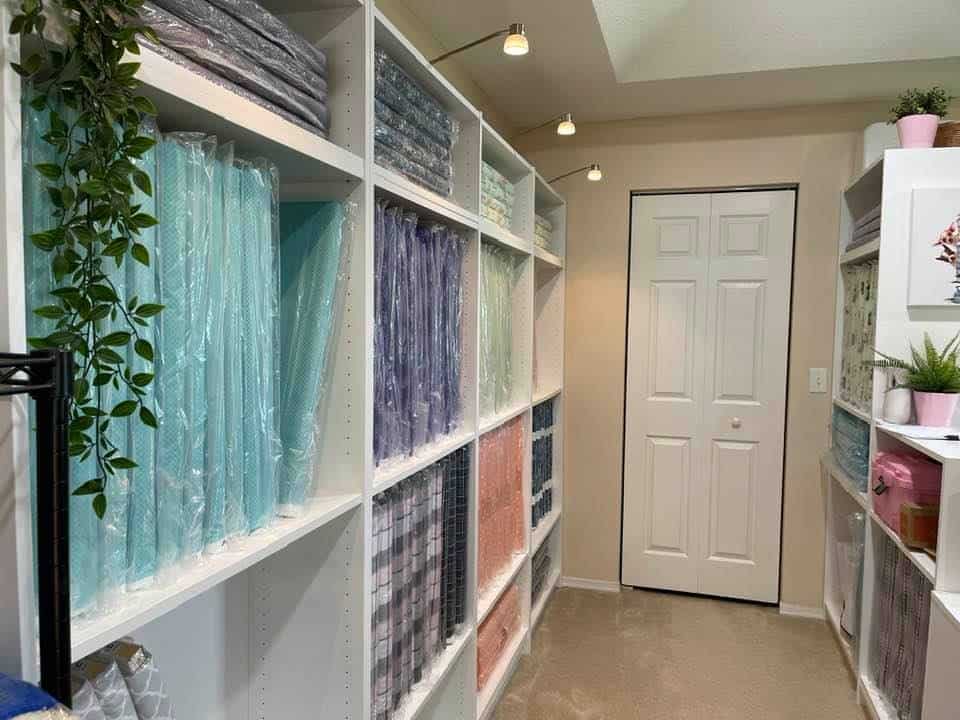
Debbie Gilbert of Natural Body Comfort recommends using bookshelves with adjustable height shelving for storing bolts of fabric.
recommends using bookshelves with adjustable height shelving for storing bolts of fabric.
Shelving is a common theme in the storage systems that Artisan Shopping Directory members use, based on the photos they sent me when I asked them about their art studio storage systems.
This also gets things off of the floor, so it keeps supplies clean and maintains a good walking path through the floor.
When you have your things all over the area that you need to walk in, it’s bad feng shui, which basically translates to “get your stuff out of my way so I don’t trip over it while I’m trying to walk across the room.”
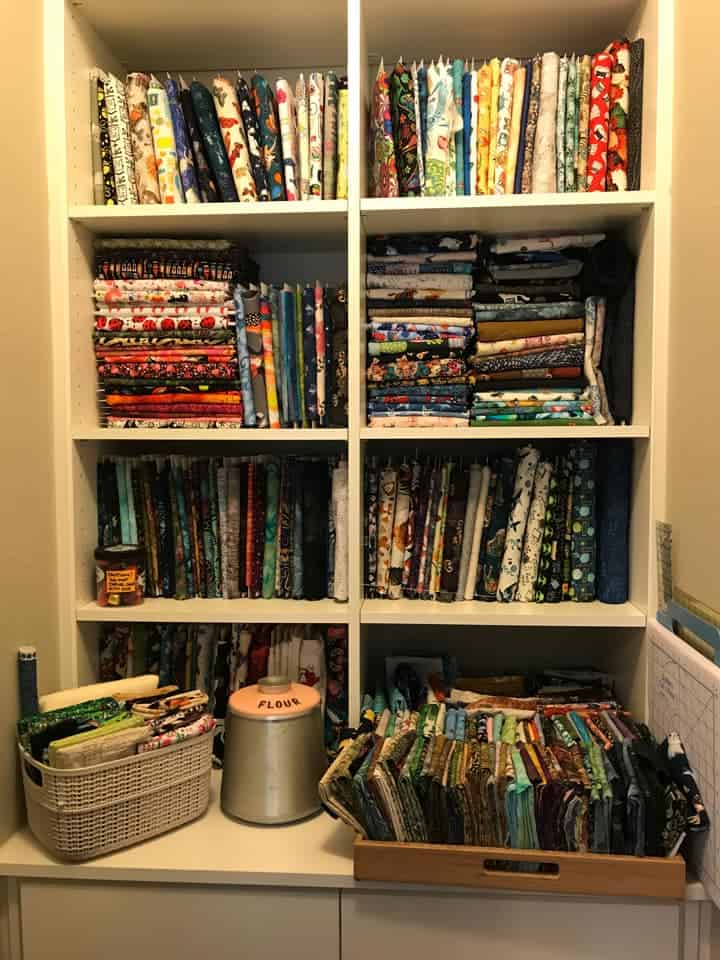
If you don’t have fabric on bolts, but you still want to be able to see what you have on hand, take a tip from Alexandria of Hudson Scrub Caps .
.
She says “I create mini fabric bolts for smaller yardages of fabric using comic book boards to fold fabric around.”
I’m a quilter, so I have a lot of smaller pieces of fabric that I keep on a shelf, but I like the idea of stacking the fabric upright like this. It makes it easier to see what you have instead of having it cover up the piece below it as they sit flat.
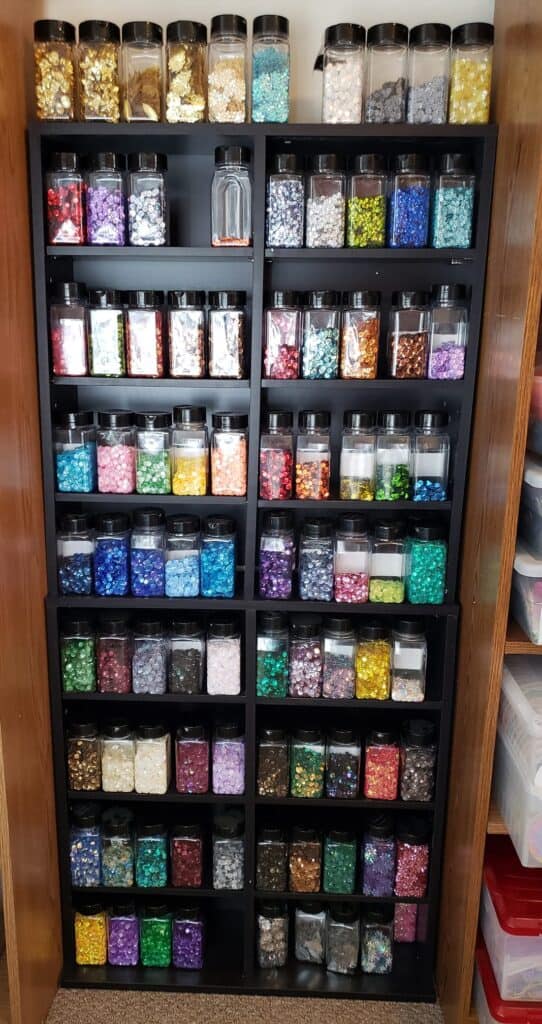
Bill Mason of Holidays Lane doesn’t use fabric, he uses beads and sequins to make ornaments and bowl fillers. (Check out his sequin and bead Christmas ornaments kits here.)
doesn’t use fabric, he uses beads and sequins to make ornaments and bowl fillers. (Check out his sequin and bead Christmas ornaments kits here.)
This is his sequin storage cabinet.
“I store my sequins in these 9oz clear plastic spice jars. It’s easy to see the sequin color and finishes. You can pour them out quickly to work on your project. I have repurposed DVD/CD storage shelves and the height of the spice jar is just a little smaller than a DVD case so the adjustable shelves are perfect matches. (My sequins are organized by type so top shelf are shapes, hologram sequins are the next down. On the left are satin/glossy sequins and the right side are metallics).”
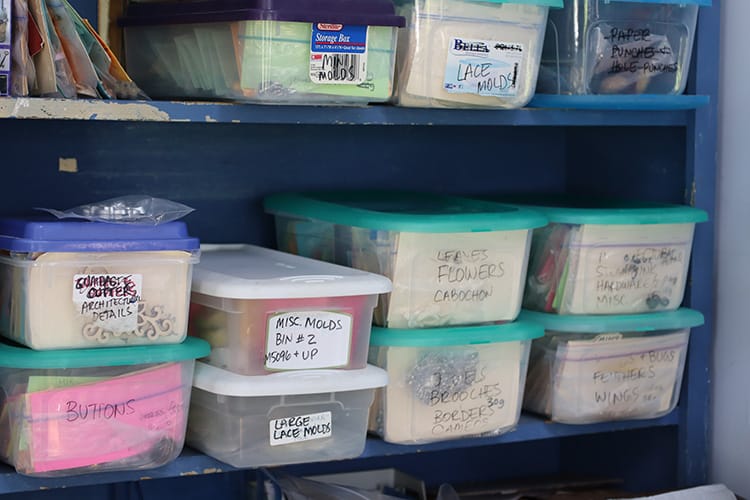
For the silicone molds that I make , I use a lot of vintage items and things like sea shells to make the molds. I store them in plastic shoeboxes, and each one is numbered so that I can pull the ones that I need quickly.
, I use a lot of vintage items and things like sea shells to make the molds. I store them in plastic shoeboxes, and each one is numbered so that I can pull the ones that I need quickly.
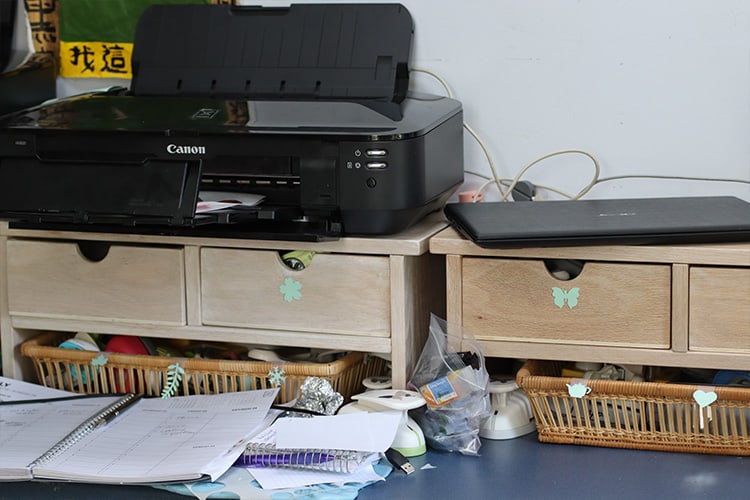
I also use paper punches to cut shapes out of my wafer paper items, and the punches were a real problem for storage.
I like to keep them in drawers so that they’re not all out in the open, but the cabinets that I found for art supply storage that had drawers were all too short and the larger punches wouldn’t fit.
Matt of Good Wood Neighborhood was asking people about what kind of storage options we were looking for, and he designed some tabletop monitor stands that had drawers that were deep enough to store the largest of my paper punches in.
was asking people about what kind of storage options we were looking for, and he designed some tabletop monitor stands that had drawers that were deep enough to store the largest of my paper punches in.
I got one, and liked it so much I bought another one.
I put my printers and printer computer on the top, and the drawers hold the punches and dies. There’s additional space under the drawers that I put baskets in with more punches, so now they’re all contained in one area.
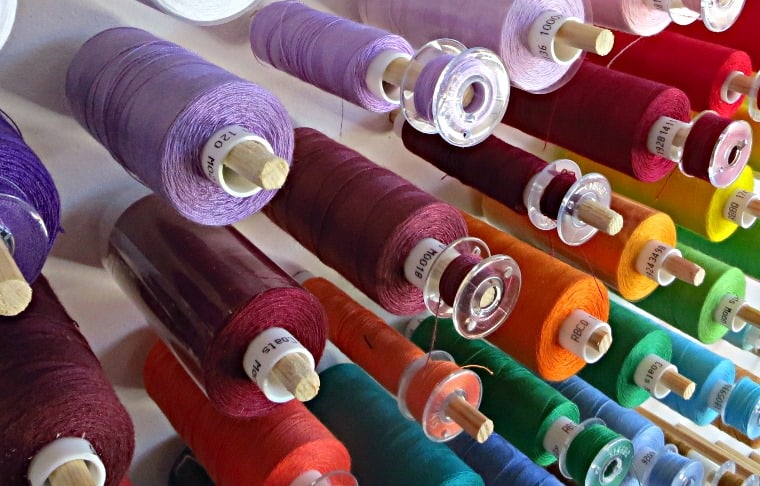
Catherine of Memory Thread Company uses this system that makes all the people who sew really jealous about her thread storage… “My husband made me a board with dowels which covers most of one wall for storing my threads. I was very insistent that the dowels had to be long enough for the spool and the bobbin to be stored together!” That’s good planning, in my opinion.
uses this system that makes all the people who sew really jealous about her thread storage… “My husband made me a board with dowels which covers most of one wall for storing my threads. I was very insistent that the dowels had to be long enough for the spool and the bobbin to be stored together!” That’s good planning, in my opinion.
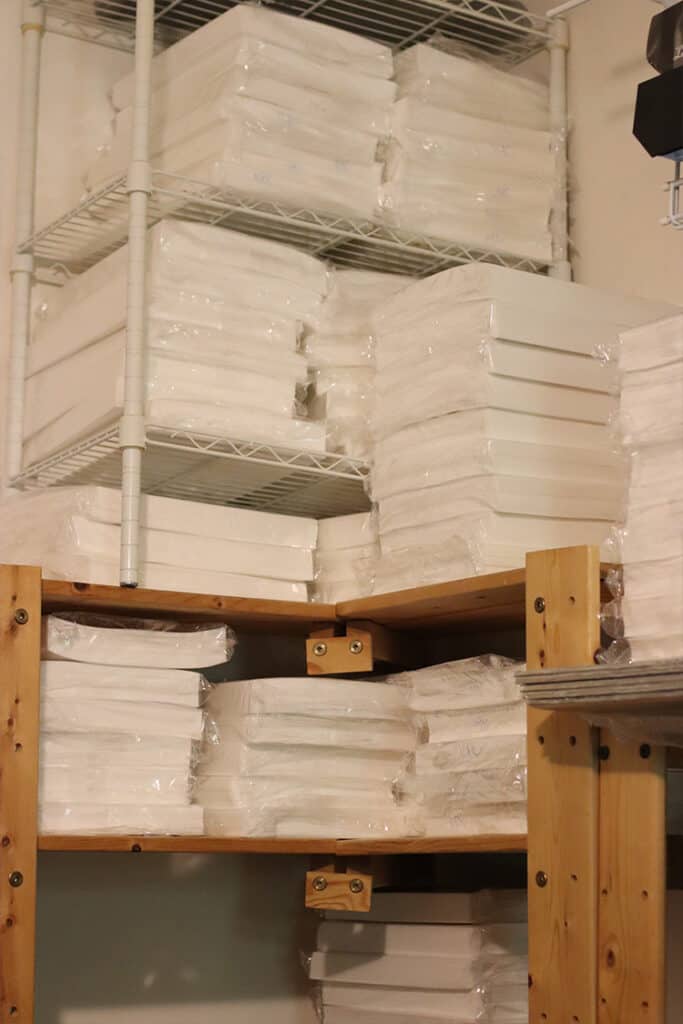
I also use shelving to store my wafer paper in my “office,” aka the extra room.
I used to actually use this room as an office, but I took the desk out and the walls are lined with shelving that holds my larger supplies and shipping boxes.
Basic shelves all the way around an extra room, or even a large closet, can be a good way to store any number of things.
Extending storage space up the wall, as opposed to putting in a lot of shorter cabinets, is sometimes the best option as far as maintaining the feel of a larger room.
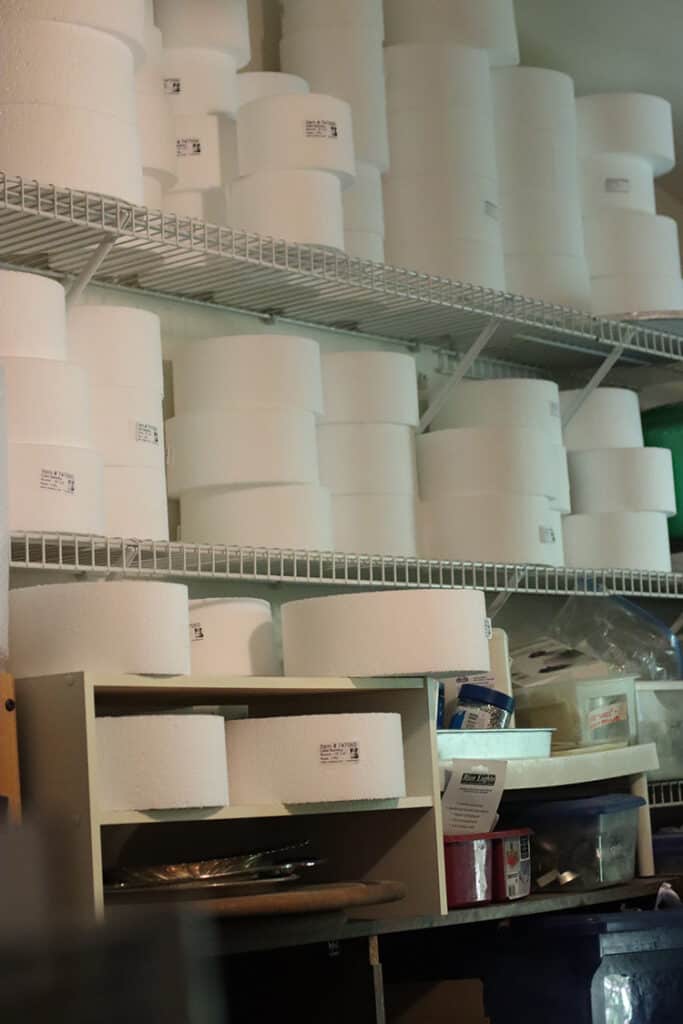
I also use wire closet shelving higher up the wall that holds lighter things, like these styrofoam cake dummies.
Shelving that’s attached over desks or work surfaces is a good option that allows for storing items while still leaving room for a work surface on the floor.
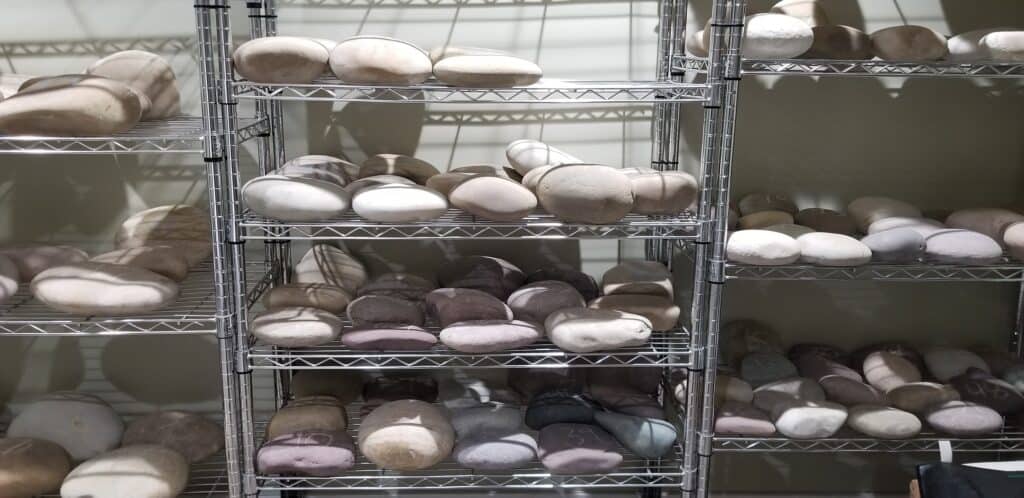
Kelly of Kimmer and Company makes custom pet memorial stones, and she uses heavy-duty wire racks for her materials.
makes custom pet memorial stones, and she uses heavy-duty wire racks for her materials.
She also uses wire closet shelving above her workstation inside, and there are photos of that coming up.
How to keep surfaces clear to work, but also keep tools handy.
It’s important to have enough flat workspace in your studio space, and that takes up a lot of floor space.
A lot of people will go up instead of using more floor space when it’s time to organize.
Others use custom workstations that combine the work area with storage underneath, or that have fold-out sections to work on.
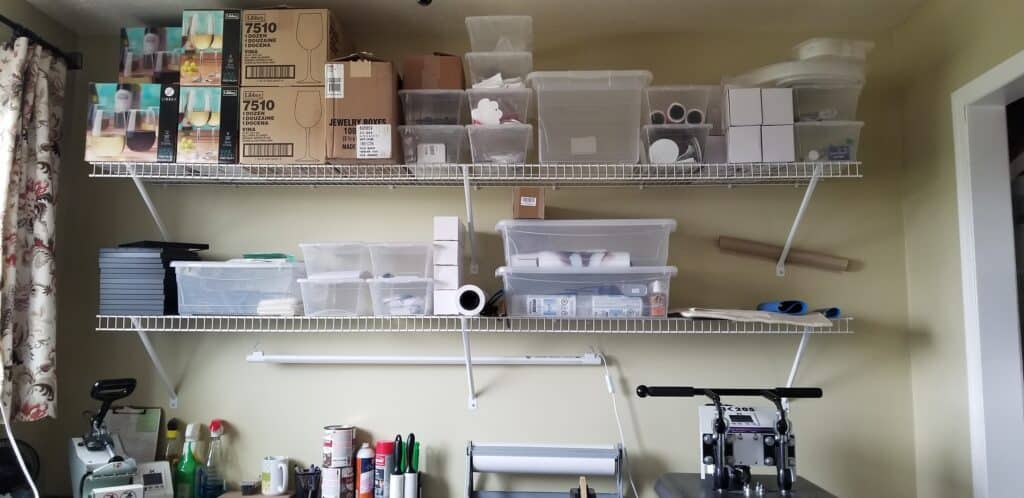
Kelly uses wire closet shelving above a workstation to store additional materials.
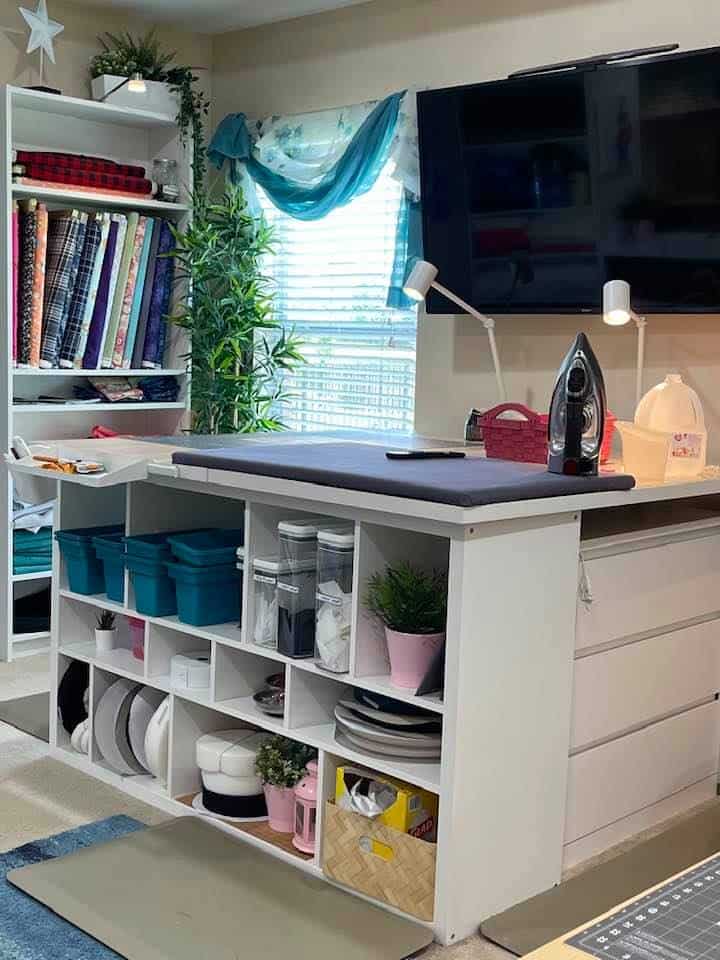
Debbie uses this combination storage and work area. “Cutting and work table doubles as extra storage space for materials with divided spaces and drawers. Using every inch for storage space as there’s no such thing as extra storage space!”
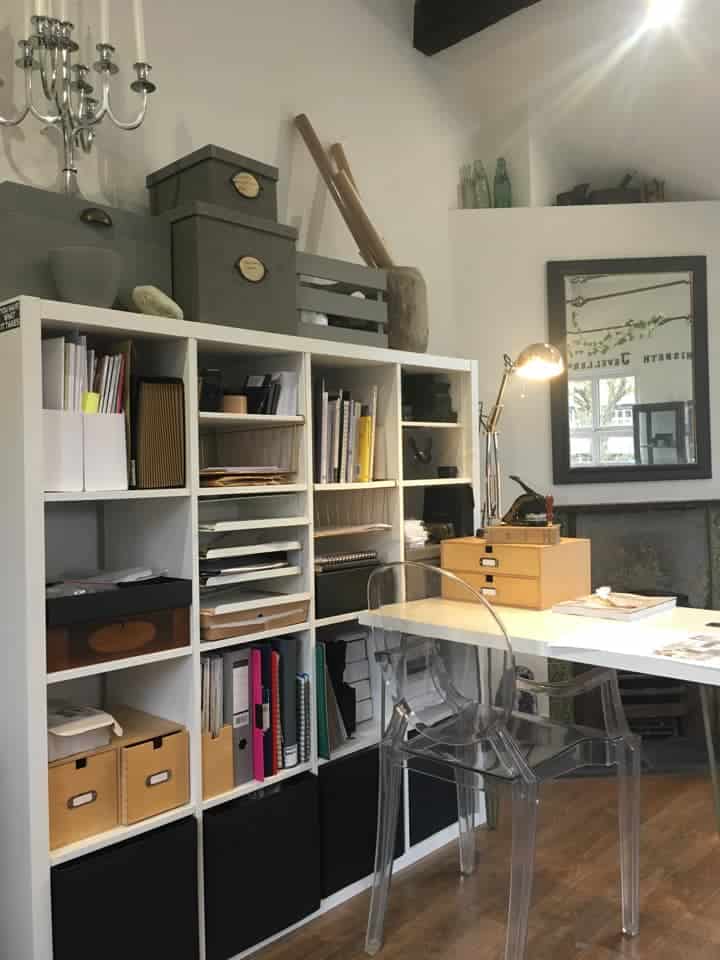
Emily of Emily Lisbeth Jewellery has this desk area set up with bookshelves as office storage.
has this desk area set up with bookshelves as office storage.
Modular units like this are good because you can usually get accessories like the drawers on the bottom that convert a cube to a drawer instead of a shelf.
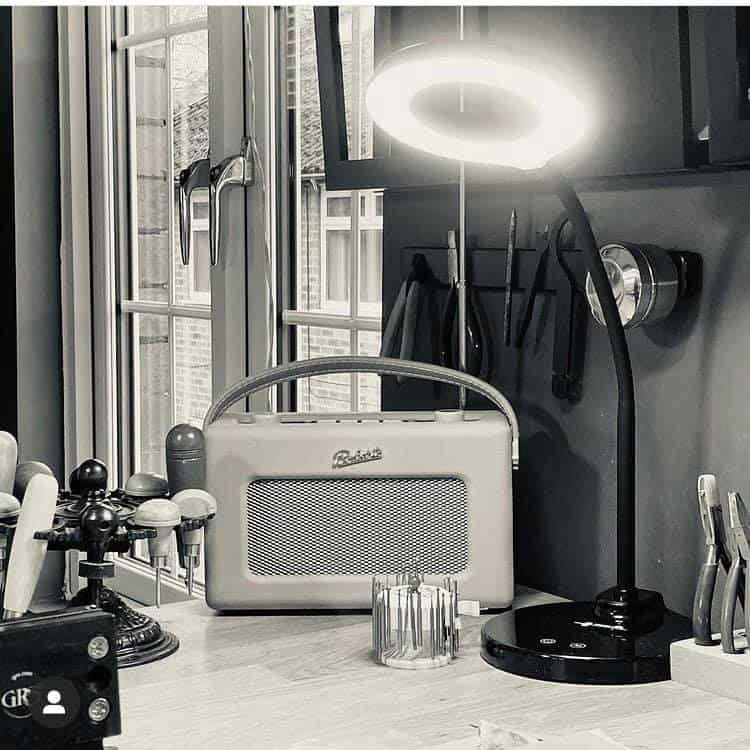
Emily also does what a lot of craftspeople do when we use things that are intended for one purpose for a different one.
Her jewelry work area has some non-jewelry tools on the table.
“I have an old post office stamp holder for my burrs and gravers and magnetic knife racks to hold my jewelry files.”
It’s pretty common for artists to use weird items for storage, because our tools can be strange shapes that don’t fit in typical storage containers.
Or we need to have things out and available, so the storage containers that are available for put-away storage won’t work.
Kitchen supply stores, office supply stores, and home supply stores are often better places to find storage options than craft stores.
I’ve used fishing tackle boxes for sewing supplies and hardware cabinets for piping tips and bead storage.
Sometimes the storage options at craft stores are designed more for looks than for usefulness, so don’t limit yourself to those options (even if they’re made in cute colors.)
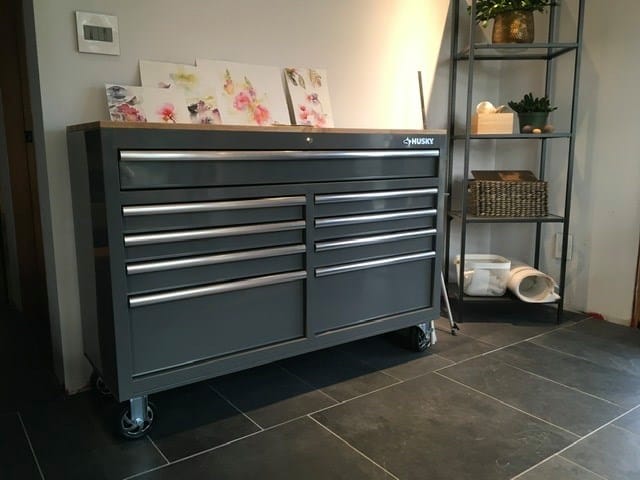
Suzanne Rorick of S Rorick Art says “I recently purchased a tool chest on sale for the storage capability and awesome wood table top. It works perfectly for my paint supplies and smaller paper storage.” I would say that was a good purchase.
says “I recently purchased a tool chest on sale for the storage capability and awesome wood table top. It works perfectly for my paint supplies and smaller paper storage.” I would say that was a good purchase.
If you can’t find what you’re looking for, you can always make your own workstation or storage unit.
Right now I have my eye on a cabinet at the Container Store that I think can be put on a little rolling cart if I can’t add casters to it.
That will make a rolling cabinet that I can push around inside my garage and keep my mold-making supplies in.
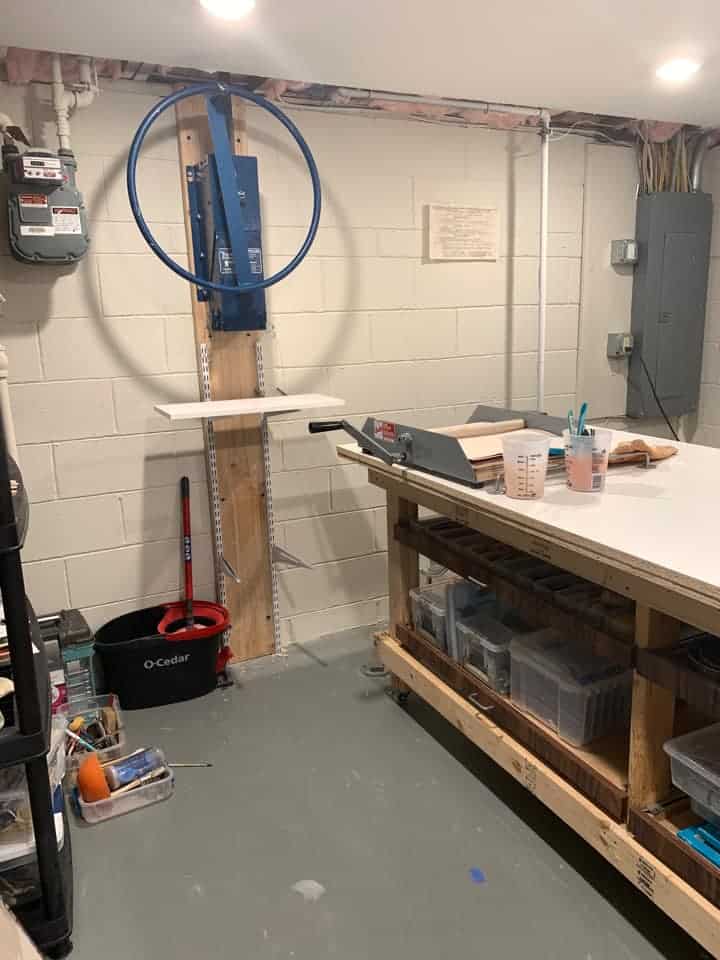
Anni of Magpie Mischief had a custom workbench built, and it uses large drawers that were meant for blueprints to store her pottery tools.
had a custom workbench built, and it uses large drawers that were meant for blueprints to store her pottery tools.
“I had my dad build a woodworking bench and outfit it with old blueprint drawers for pottery tools and cookie cutters. The work table bench is also on casters so I can roll it around my studio depending on which space I need to be working in.”
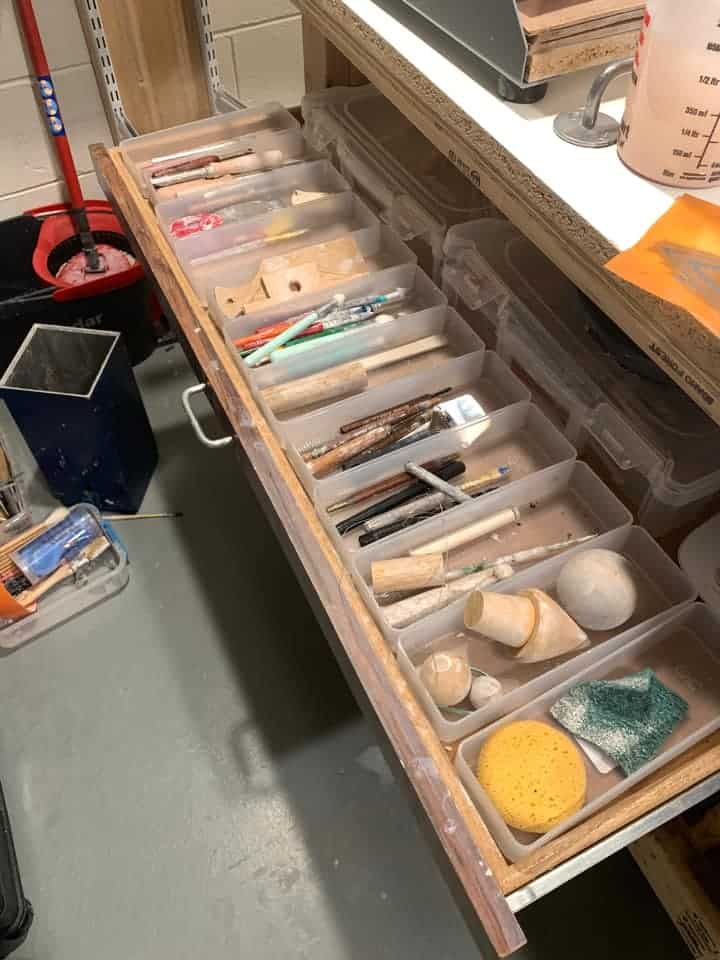
A place to put machines that we use on a regular basis.
A common problem that people who use printers or laser cutters in their businesses have is that the machines take up so much surface space on the counters.
The solution is often to go vertical, using shelves, racks, or stands like the monitor stands I mentioned that I use before.
People also use deeper tables that allow them to store other things against the wall as well as using the flat space.
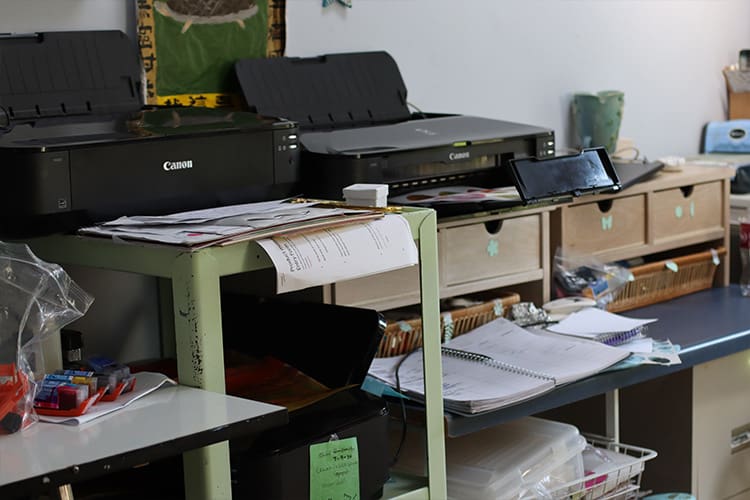
I use the monitor stands that raise my printers off of the surface and allow for storage under them, but I also have an old AV rolling stand that I got from the local elementary school.
It’s built to hold projectors and other AV equipment, so it works well for printers.
I have two printers on the stand, and the third one goes on the monitor stands with the computer that runs them all.
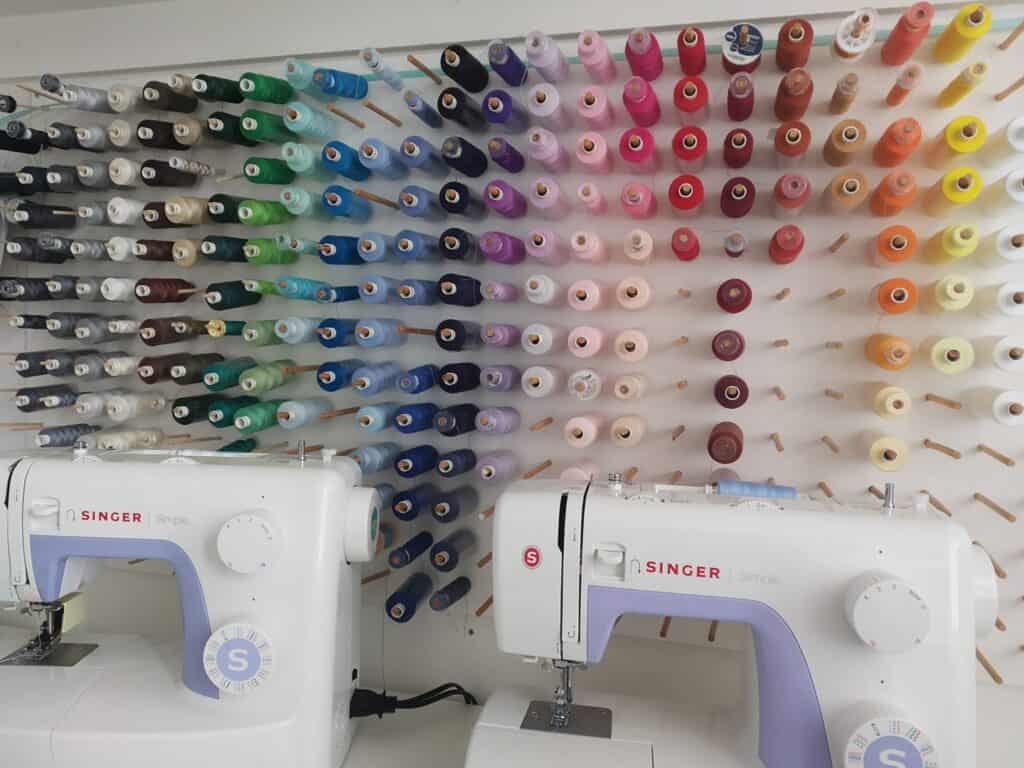
Catherine’s thread board is located behind a sewing machine workstation.
This is a really good location because it gives you easy access to the thread that you’ll need for sewing, obviously, but the thread wall also uses space that would otherwise not be used for anything.
Places to dry things.
If you’re a painter, a ceramist, or you make things that need to cure, like soap, you’ll need a decent amount of space to dry things.
Shelving is the obvious choice, but the cost of shelving can add up, and if they’re stationary shelves they might take up a lot of space and have limited dimensions that limit the height of things you can put on them.
I use a speed rack with trays because you can roll them around and adjust the space between them by leaving a tray out.
because you can roll them around and adjust the space between them by leaving a tray out.
Speed racks are the metal racks that kitchens use, and I found some plastic cafeteria trays that fit on the one that I bought.
When I made gumpaste flowers I put them on the racks to dry, and since it has wheels I could push it into different rooms out of the way while I was working.
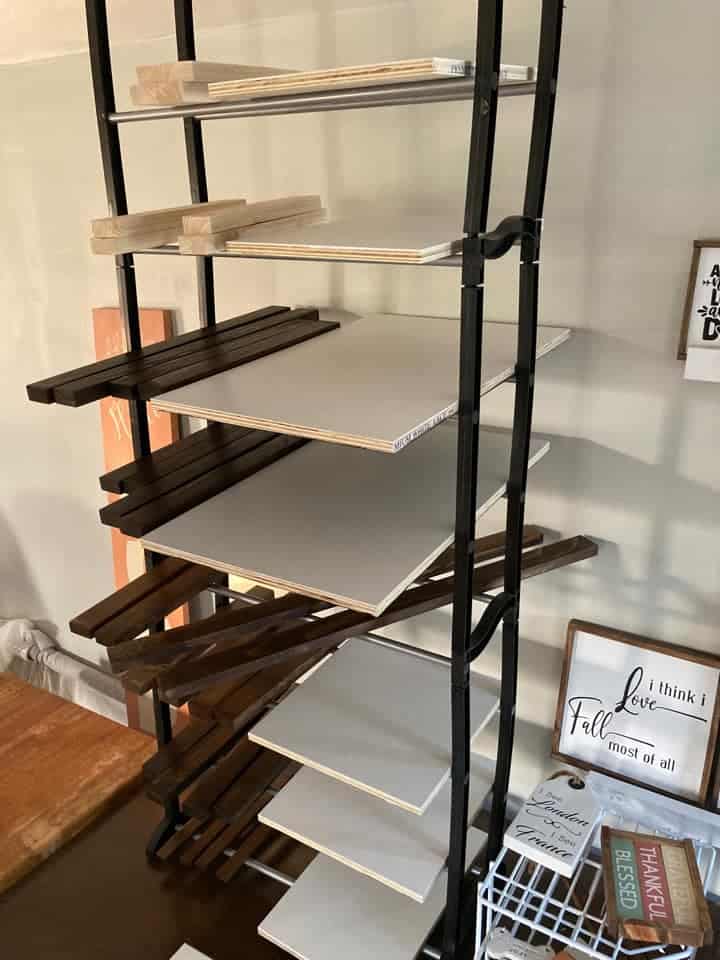
Destiny Karsner of Home Branded got around the cost of a drying rack by using a less expensive option.
got around the cost of a drying rack by using a less expensive option.
“I make wood signs and this helps keep my frames and boards organized as well being a great place to let them dry. Since it’s vertical it frees up my table space for painting or staining. It is a shoe rack that I picked up from Tuesday Morning for $15. I’ve heard of people finding metal storage at hobby lobby for $15.”
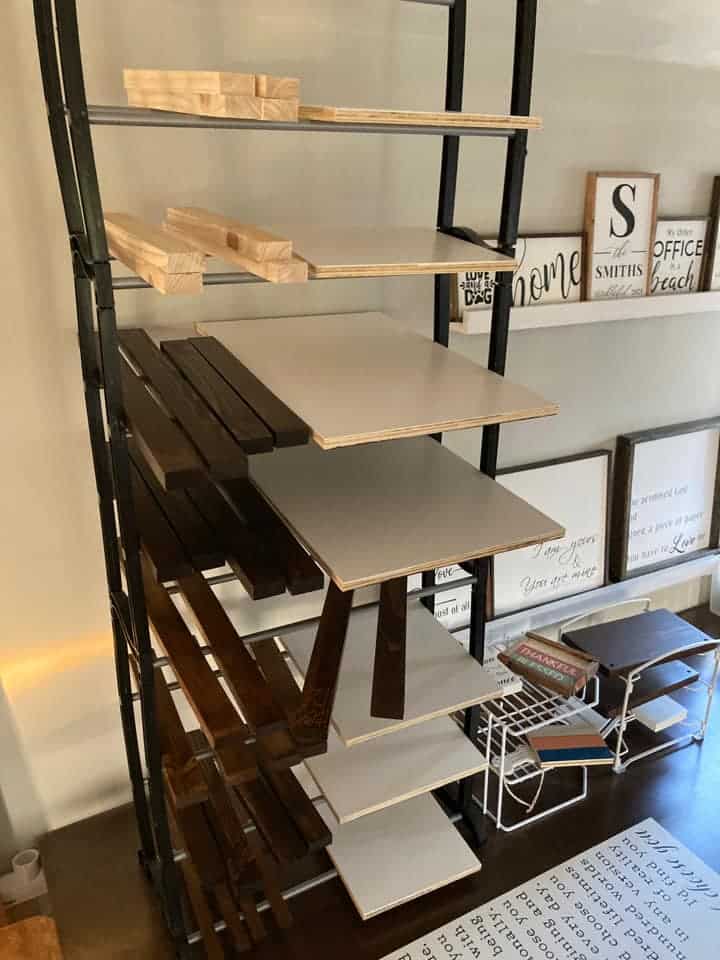
Safe storage for liquids.
If you use liquids in your artwork or crafting, you’ll need to be able to store the containers upright to avoid spills, and this can take up a lot of room.
If you use a cabinet to store them it can make it more difficult to find what you’re looking for because you’ll be digging through layers of bottles and jars.
Having things out where you can see them makes it easier to grab your materials.
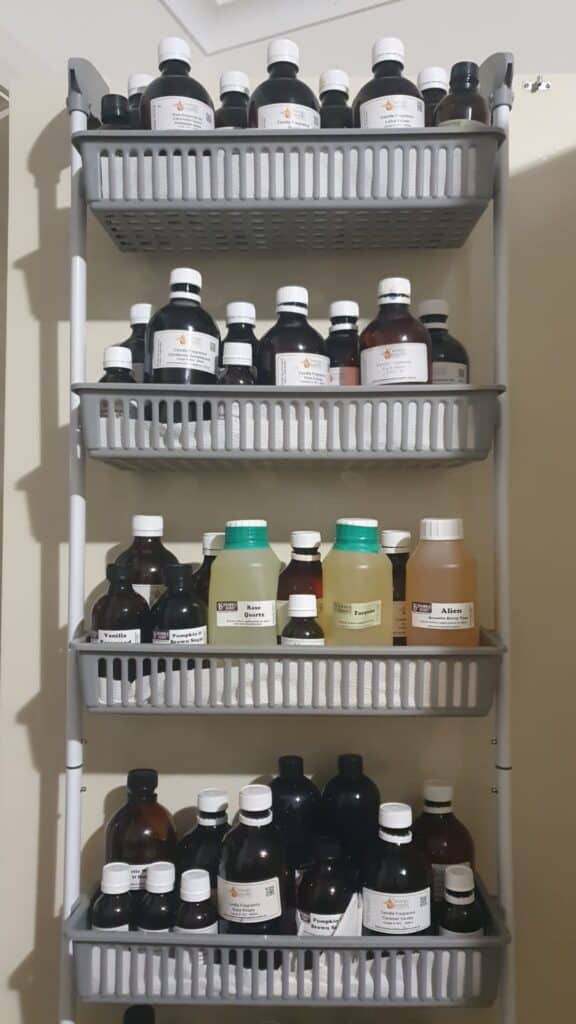
Jes Ware of Sixth Spice makes bath and body products.
makes bath and body products.
She says “I store my fragrance oils on an over-the-door storage basket… they are inside the closet in my work room.” Over-the-door storage racks are a good option because they give you additional shelves and you can close the door to get it out of your sight if you’re tired of working!
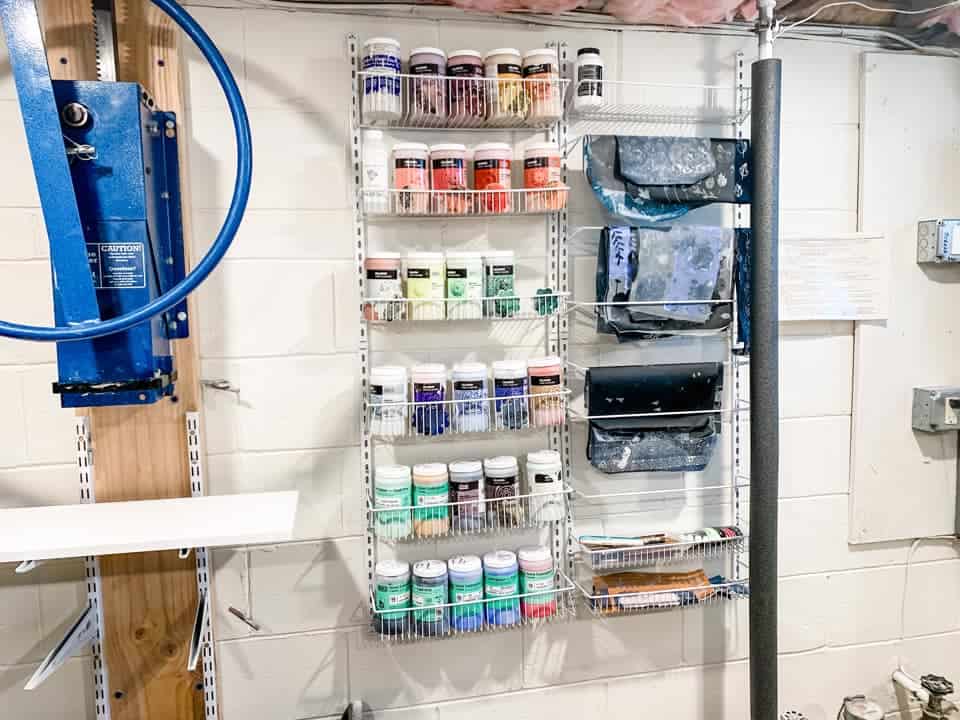
Anni says “I use spice racks for glazes, kiln posts, and inventory.” These racks are great for bottles or containers in general. and they let you see exactly what you have in stock to work with.
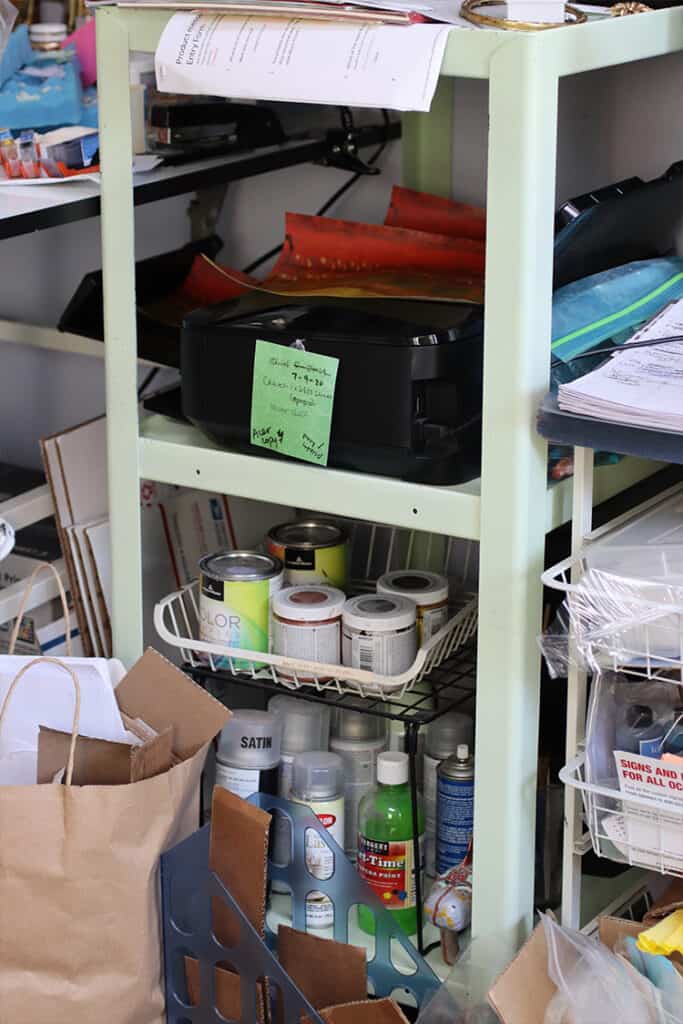
I keep my paint on the bottom shelf of the AV cart, and I have an extra shelf that’s meant to be for a high school locker on it to give me an extra level of storage.
Taller bottles and cans go under the rack, and a basket with shorter bottles is on top.
A safe workspace for jobs that require ventilation.
If you work with chemicals like lye for soap making, or epoxies that need good ventilation, it’s important to take precautions.
Even things that don’t come with safety warnings can cause problems if you don’t use the right protective equipment.
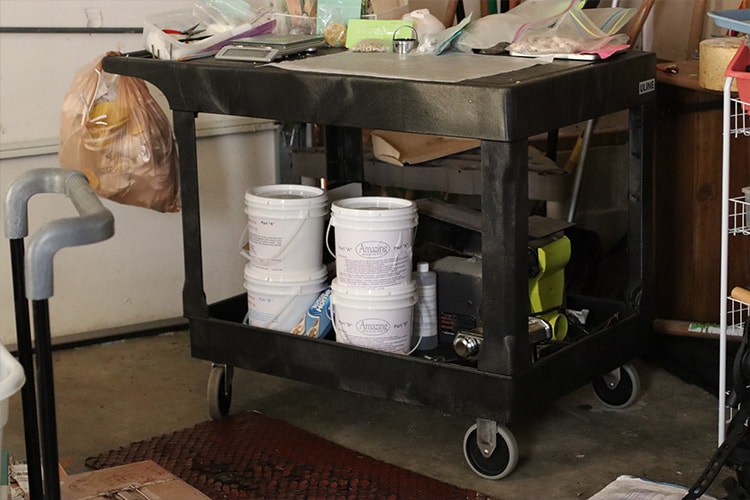
I found this out the hard way when I developed a reaction to a new type of liquid silicone I was trying out.
After two rounds of steroids, the doctors told me not to use that kind of silicone again.
Luckily, the type that I normally use doesn’t bother me, but I did start using it outside, and I wear an N95 mask when I make molds to avoid breathing in any fumes.
I bought this cart and I keep the silicones there along with some other tools.
I can roll the cart outside in the fresh air when I work if the weather is nice, and that helps with having more air circulation.
My neighbors give me weird looks, but only one has come up to ask me what I’m doing, so I can’t help wondering what the rest of them think I’m doing!
Shipping and packing supply storage and work area.
Another thing that home-based eCommerce business owners have to think about is storage for shipping supplies.
It’s a lot less expensive to buy boxes and packaging in bulk, but then you have to store it somewhere.
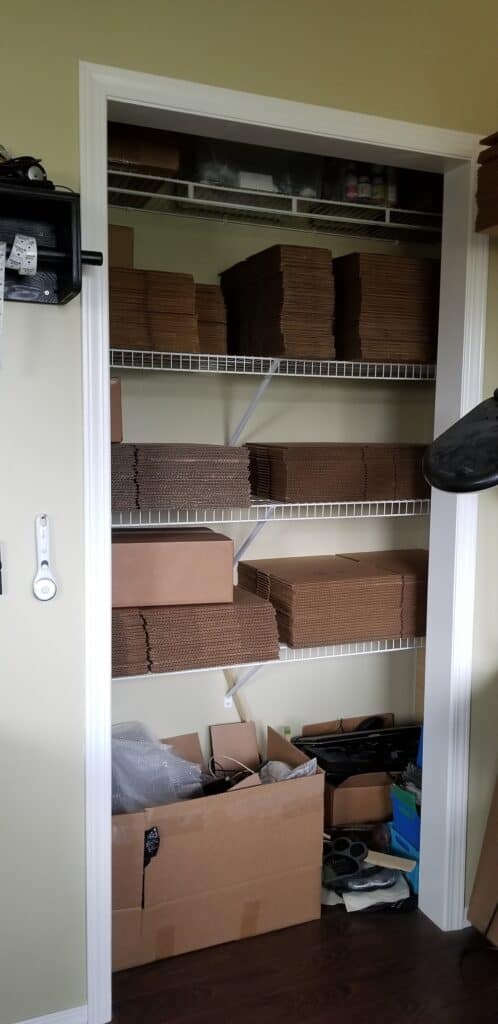
Kelly uses a closet to store boxes…
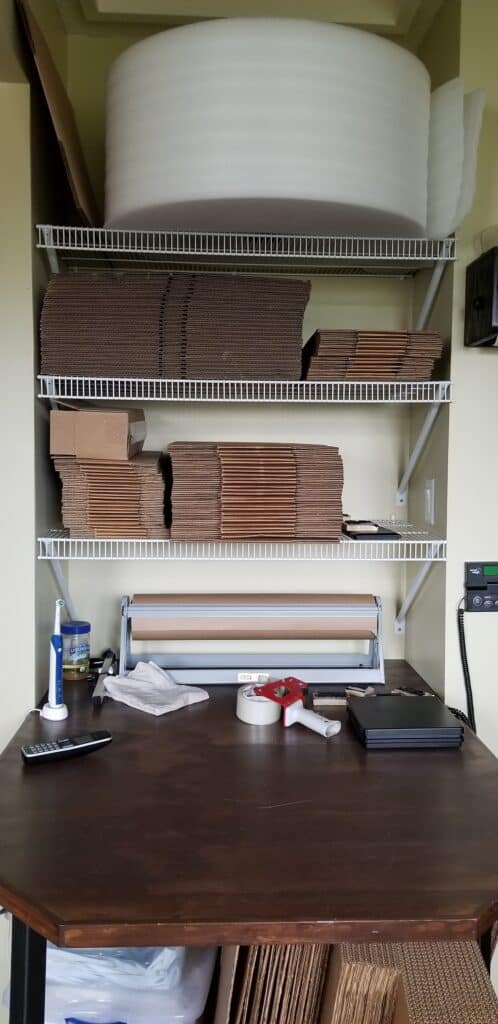
…And uses this area for packing orders.
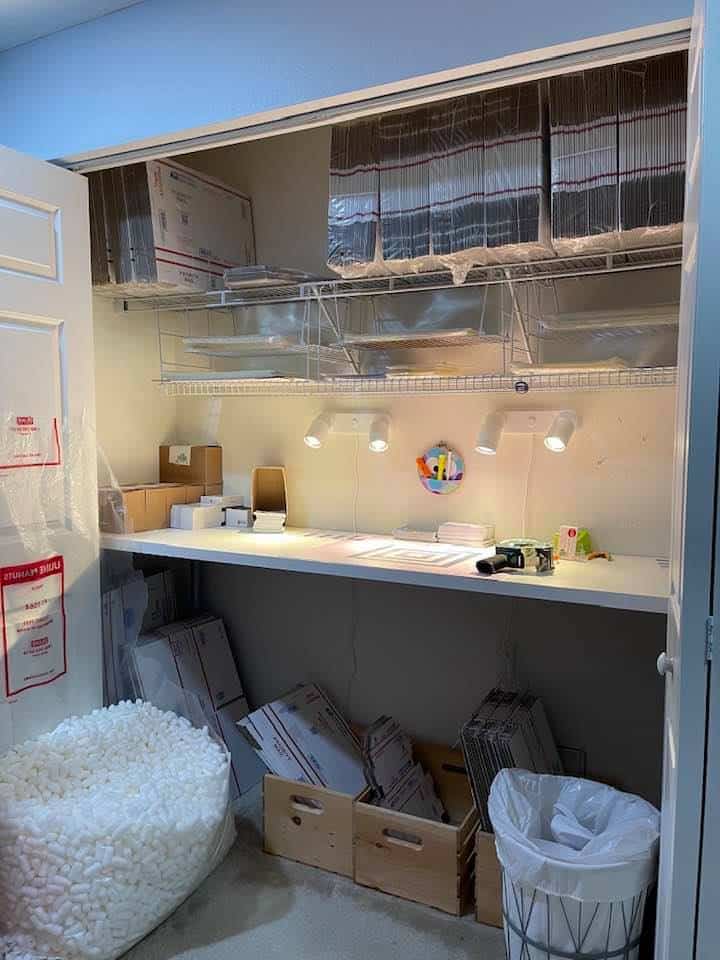
Debbie has also converted a closet into an actual shipping station with all of the materials handy.
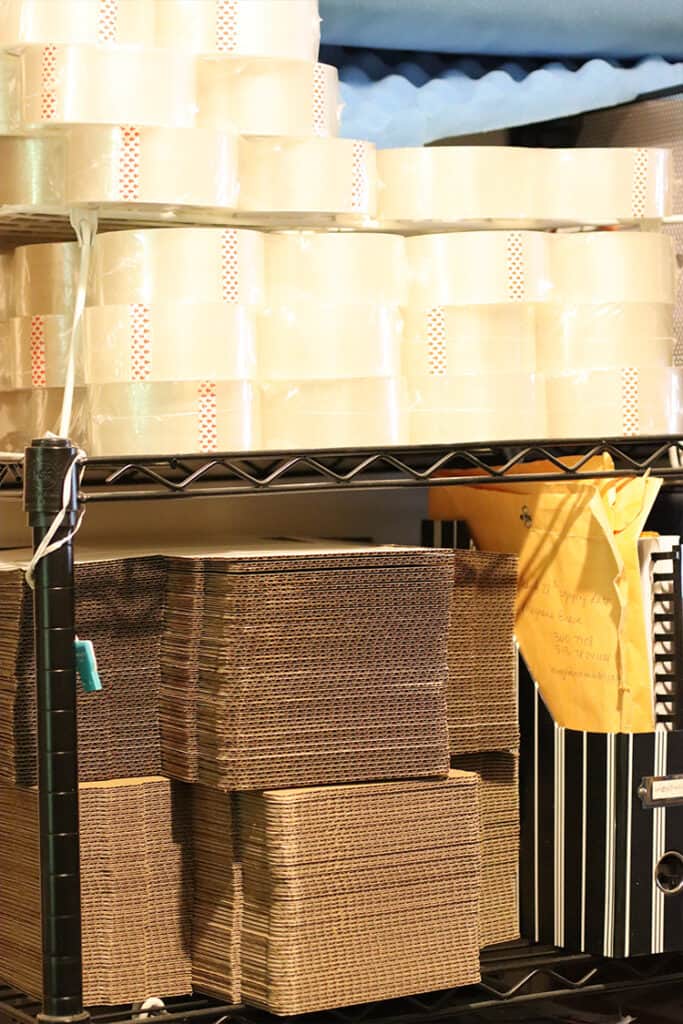
I use shelving in my storage room/office to hold boxes and tape (yes, that’s all tape, it’s cheaper in bulk.)
I use about 5 or 6 different box sizes, so I have boxes and shipping materials anywhere I can put them.
Consider setting up a dedicated shipping area where you can pack orders if you send things every day, or at least have the packaging materials in a place where you have easy access to them.
Until you need the supplies, they can be stored somewhere else, including places like under your bed.
Put them anywhere they’ll fit, and bring out enough to stock yourself for what you need each day.
Places to keep inventory of supplies and finished products.
We don’t just have to think about shipping and crafting supplies, though.
We also need to think about what to do with the things that we’ve made that are ready to ship.
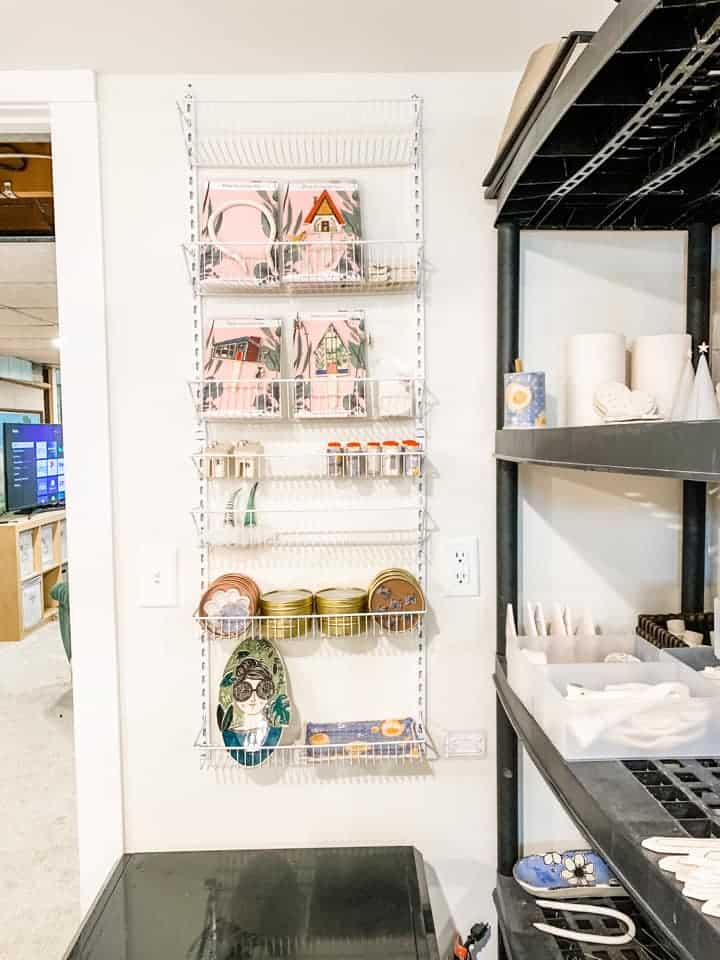
Anni uses wall racks and shelving to store finished ceramic pieces.
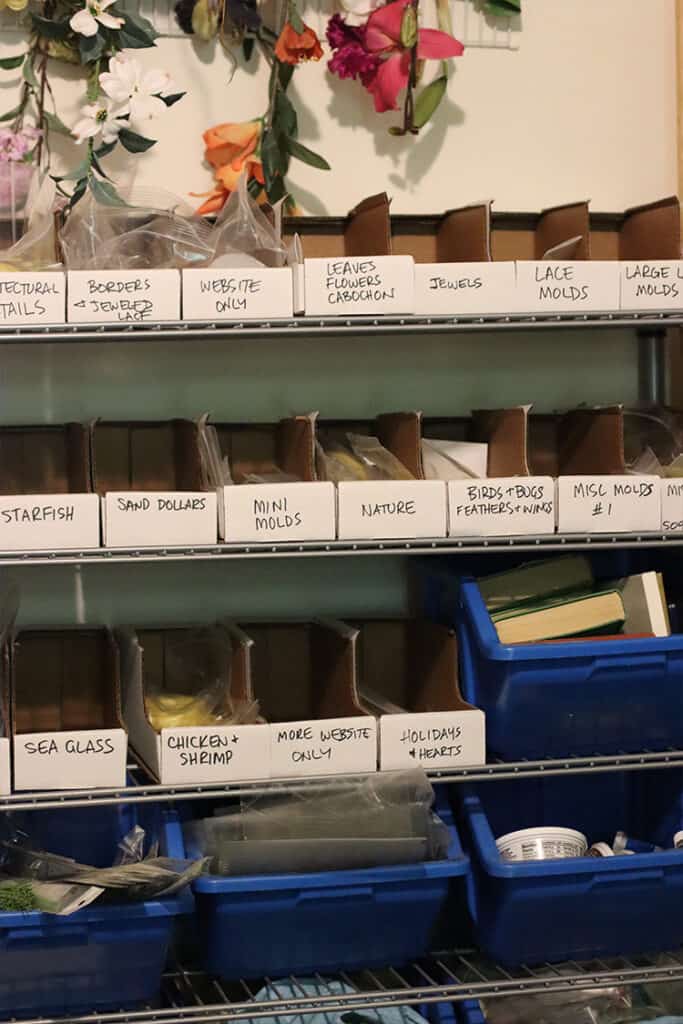
I use wire racks that I got at Sam’s Club and some cardboard boxes that were meant to hold things like nails and screws that I use to hold silicone molds that are made up ahead of time.
The plastic bins that came with the racks also hold some of the books that I sell in my vintage shop .
.
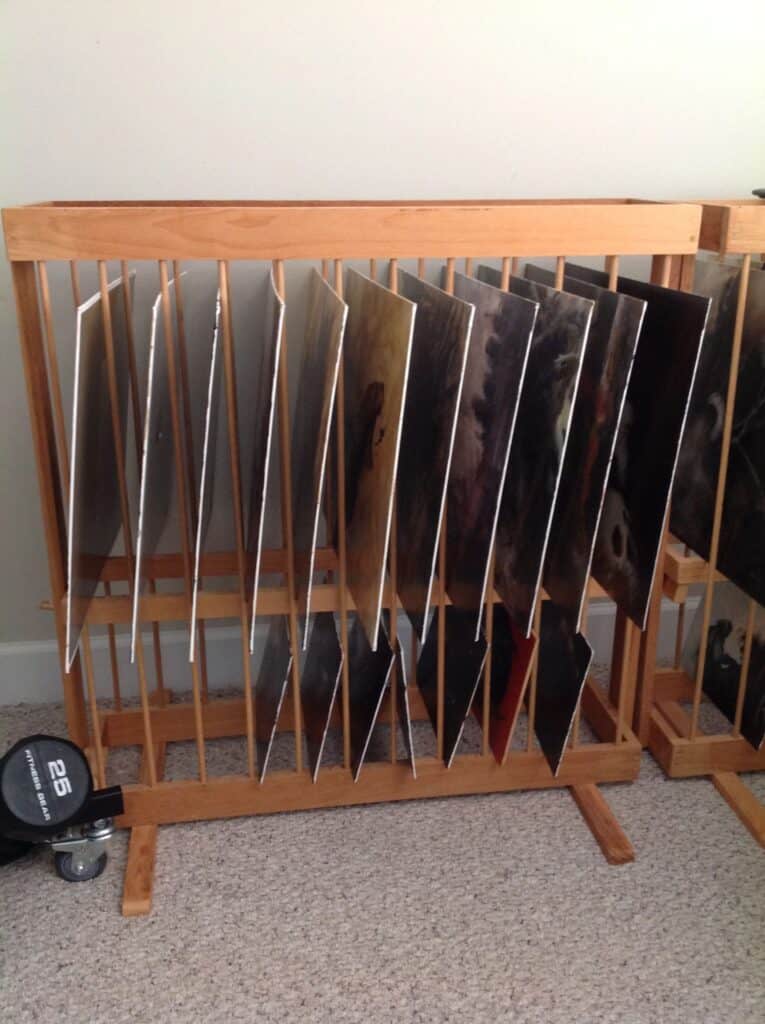
Doug Hoppes of ShadowMyths took a low-cost approach to the storage rack for his paintings.
took a low-cost approach to the storage rack for his paintings.
“This is a homemade stand that I use to store my paintings after they have dried. The 18 x 24 are on top and 9 x 12 are on the bottom. It’s a simple design with dowel rods.”
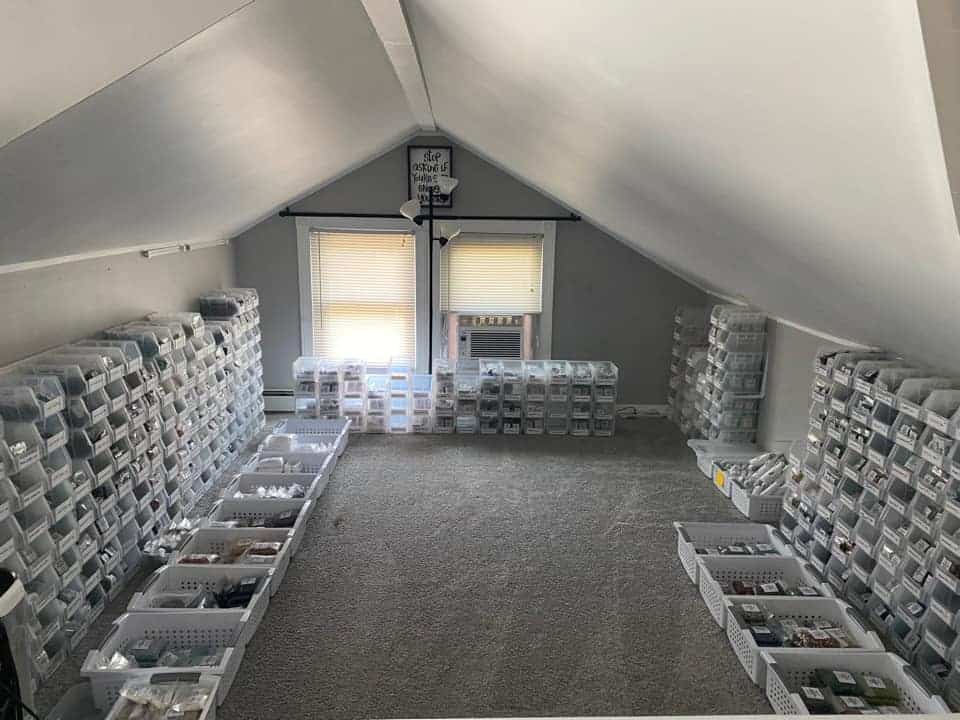
Tracy of Happy Nook Shop has put the bonus room in her house to good use by filling it with her inventory!
has put the bonus room in her house to good use by filling it with her inventory!
She uses the same stackable bins that I have on my wire shelving.
And speaking of using an entire room in your house for your inventory, let’s talk about the problem of your art studio expanding into other parts of your house.
Minimizing “the creep” of supplies into other parts of the house.
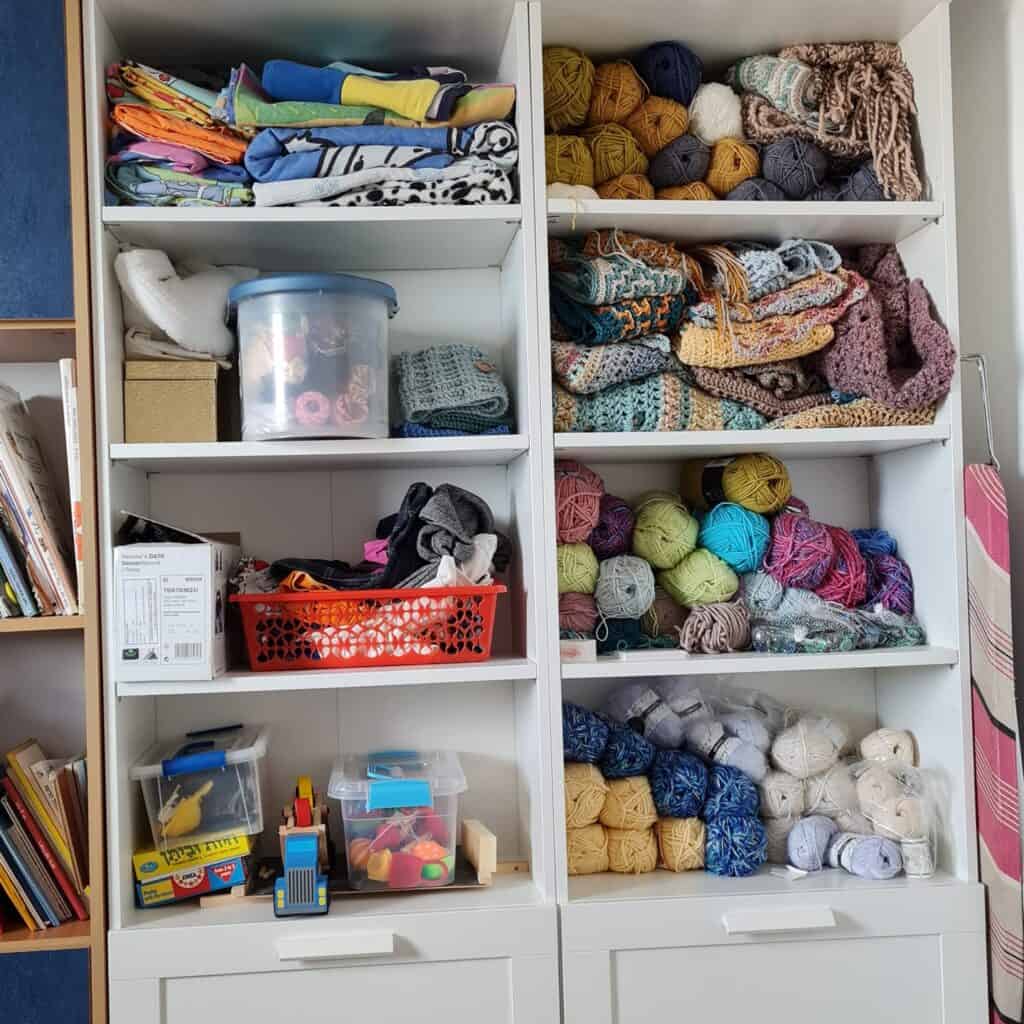
We’ve all experienced “the creep,” when your supplies or business equipment slowly expands into the family living area.
There are all kinds of business books that say you shouldn’t let this happen under any circumstances, and that it will destroy your life if you can’t close a door and have your business be behind the door.
However, although it would be really nice to be able to do that, it isn’t realistic for more home-based businesses.
I’m writing this at 8:20 pm on a Thursday, and when I look to my right I see two giant boxes of poly mailers that have been in the corner of my living room for about three months.
They won’t fit in the office, so oh well, they’re in the living room, no big deal.
Sandra, who owns SandraStitchesIL, sent this photo of her yarn storage next to her grandson’s toys on a bookshelf.
That is totally normal even though people pretend that we all work in a perfectly designed art studio with flowing white curtains and floor-to-ceiling windows that open to an ocean view.
My actual workspace view includes our back fence and my neighbor’s shed, no ocean in sight.
My advice would be to try to avoid “the creep” as much as possible, but don’t feel too terrible if your work oozes into your family space. It happens, let’s not pretend.
Try to minimize it as much as possible, but if you end up sitting next to a couple of giant boxes of poly mailers in your living room, just know that you’re not alone.


